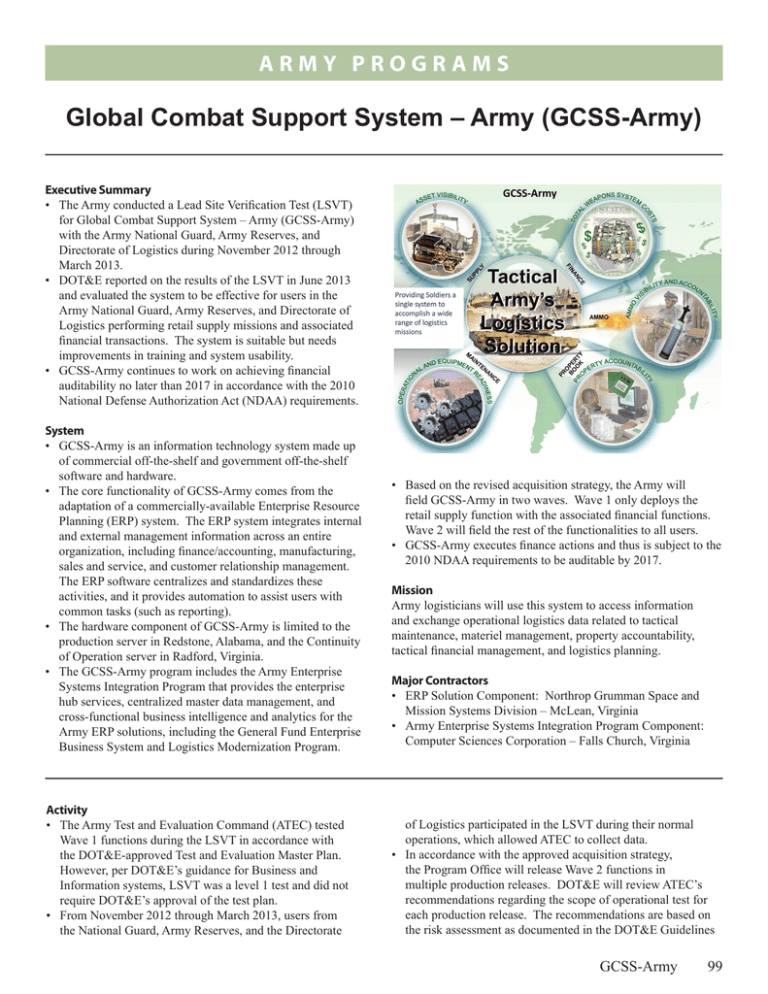Global Combat Support System – Army (GCSS-Army)
advertisement

ARMY PROGRAMS Global Combat Support System – Army (GCSS-Army) Executive Summary • The Army conducted a Lead Site Verification Test (LSVT) for Global Combat Support System – Army (GCSS-Army) with the Army National Guard, Army Reserves, and Directorate of Logistics during November 2012 through March 2013. • DOT&E reported on the results of the LSVT in June 2013 and evaluated the system to be effective for users in the Army National Guard, Army Reserves, and Directorate of Logistics performing retail supply missions and associated financial transactions. The system is suitable but needs improvements in training and system usability. • GCSS-Army continues to work on achieving financial auditability no later than 2017 in accordance with the 2010 National Defense Authorization Act (NDAA) requirements. System • GCSS-Army is an information technology system made up of commercial off-the-shelf and government off-the-shelf software and hardware. • The core functionality of GCSS-Army comes from the adaptation of a commercially-available Enterprise Resource Planning (ERP) system. The ERP system integrates internal and external management information across an entire organization, including finance/accounting, manufacturing, sales and service, and customer relationship management. The ERP software centralizes and standardizes these activities, and it provides automation to assist users with common tasks (such as reporting). • The hardware component of GCSS-Army is limited to the production server in Redstone, Alabama, and the Continuity of Operation server in Radford, Virginia. • The GCSS-Army program includes the Army Enterprise Systems Integration Program that provides the enterprise hub services, centralized master data management, and cross-functional business intelligence and analytics for the Army ERP solutions, including the General Fund Enterprise Business System and Logistics Modernization Program. Activity • The Army Test and Evaluation Command (ATEC) tested Wave 1 functions during the LSVT in accordance with the DOT&E-approved Test and Evaluation Master Plan. However, per DOT&E’s guidance for Business and Information systems, LSVT was a level 1 test and did not require DOT&E’s approval of the test plan. • From November 2012 through March 2013, users from the National Guard, Army Reserves, and the Directorate • Based on the revised acquisition strategy, the Army will field GCSS-Army in two waves. Wave 1 only deploys the retail supply function with the associated financial functions. Wave 2 will field the rest of the functionalities to all users. • GCSS-Army executes finance actions and thus is subject to the 2010 NDAA requirements to be auditable by 2017. Mission Army logisticians will use this system to access information and exchange operational logistics data related to tactical maintenance, materiel management, property accountability, tactical financial management, and logistics planning. Major Contractors • ERP Solution Component: Northrop Grumman Space and Mission Systems Division – McLean, Virginia • Army Enterprise Systems Integration Program Component: Computer Sciences Corporation – Falls Church, Virginia of Logistics participated in the LSVT during their normal operations, which allowed ATEC to collect data. • In accordance with the approved acquisition strategy, the Program Office will release Wave 2 functions in multiple production releases. DOT&E will review ATEC’s recommendations regarding the scope of operational test for each production release. The recommendations are based on the risk assessment as documented in the DOT&E Guidelines GCSS-Army 99 Army PROGRAMS for Operational Test and Evaluation of Information and Business Systems. • DOT&E agreed with ATEC’s recommendation to conduct a test for Production Release 8, the first of the production releases for Wave 2. Production Release 8 fixed four software problems observed during the LSVT and did not add any new functionality. ATEC reported on Production Release 8 in an August 2013 assessment. Assessment • DOT&E reported GCSS-Army to be operationally effective and suitable after the IOT&E in June 2012. • The LSVT augmented the IOT&E results with data from five units that represented the Army National Guard, Army Reserves, and Directorate of Logistics. These units were not fielded at the time of the IOT&E. In a report released in June 2013, DOT&E evaluated GCSS-Army to be operationally effective for units performing Wave 1 functions but documented software shortfalls. These software problems did not prevent mission accomplishment but caused users to spend additional time and effort. The Program Office keeps track of problems and recommendations for software improvement, and implements fixes in new releases based on the priorities and available resources. GCSS-Army was suitable and needed improvement on training and system usability. • Production Release 8 was effective in fixing four of the software problems found during the LSVT. 100 GCSS-Army • The 2010 NDAA requires financial audibility by 2017. GCSS-Army has not achieved this requirement at the time of this report. DOT&E will work with the Program Office to implement a financial Red Team test of system vulnerability to cybercrime. Recommendations • Status of Previous Recommendations. The Army began addressing the three previous recommendations but further action is required. The Army still should: 1. Take steps to achieve financial auditability no later than 2017. 2. Continue to collect data for computational (server capacity, storage, and bandwidth) and human factors (help desk responsiveness, overhead labor and communication costs, and data noise) impacts of an increased user base. Use such data to establish a pattern of demand on the system, so that future demand can be adequately anticipated and resourced as more users come online. 3. Conduct test and evaluation when the software is developed for Army Reserves and National Guard units in accordance with the September 2010 DOT&E-published Guidelines for Operational Test and Evaluation of Information and Business Systems memorandum. • FY13 Recommendations. None.

